Mechanics#
Solid Bodies
|
A SolidBody with methods for the assembly of sparse vectors/matrices. |
|
A (nearly) incompressible solid body with methods for the assembly of sparse vectors/matrices. |
|
A hydrostatic pressure boundary on a solid body. |
|
A gravity (body) force on a solid body. |
State Variables
|
A State with internal cell-wise constant dual fields for (nearly) incompressible solid bodies. |
Steps and Jobs
|
A Step with multiple substeps, subsequently depending on the solution of the previous substep. |
|
A job with a list of steps and a method to evaluate them. |
|
A job with a list of steps and a method to evaluate them. |
Point Load and Multi-Point Constraints
|
A point load with methods for the assembly of sparse vectors/matrices. |
|
|
|
Detailed API Reference
- class felupe.SolidBody(umat, field, statevars=None)[source]#
Bases:
SolidA SolidBody with methods for the assembly of sparse vectors/matrices.
- Parameters:
umat (class) – A class which provides methods for evaluating the gradient and the hessian of the strain energy density function per unit undeformed volume. The function signatures must be
dψdF, ζ_new = umat.gradient([F, ζ])for the gradient andd2ψdFdF = umat.hessian([F, ζ])for the hessian of the strain energy density function \(\psi(\boldsymbol{F})\), where \(\boldsymbol{F}\) is the deformation gradient tensor and \(\zeta\) holds the array of internal state variables.field (FieldContainer) – A field container with one or more fields.
statevars (ndarray or None, optional) – Array of initial internal state variables (default is None).
Notes
The total potential energy of internal forces is given in Eq. (1)
(1)#\[\Pi_{int}(\boldsymbol{F}) = \int_V \psi(\boldsymbol{F})\ dV\]with its variation, see Eq. (2)
(2)#\[\delta_\boldsymbol{u}(\Pi_{int}) = \int_V \frac{\partial \psi}{\partial \boldsymbol{F}} \ dV \longrightarrow \boldsymbol{f}_\boldsymbol{u}\]and linearization, see Eq. (3). The right-arrows in Eq. (2) and Eq. (3) represent the assembly into system scalars, vectors or matrices.
(3)#\[\delta_\boldsymbol{u}\Delta_\boldsymbol{u}(\Pi_{int}) = \int_V \delta\boldsymbol{F} : \frac{\partial^2 \psi}{ \partial \boldsymbol{F}\ \partial \boldsymbol{F} } : \Delta\boldsymbol{F}\ dV \longrightarrow \boldsymbol{K}_{\boldsymbol{u}\boldsymbol{u}}\]The displacement-based formulation leads to a linearized equation system as given in Eq. (4).
(4)#\[\boldsymbol{K}_{\boldsymbol{u}\boldsymbol{u}} \cdot \delta \boldsymbol{u} + \boldsymbol{f}_\boldsymbol{u} = \boldsymbol{0}\]Note
This class also supports
umatwith mixed-field formulations likeNearlyIncompressibleorThreeFieldVariation.Examples
>>> import felupe as fem >>> >>> mesh = fem.Cube(n=6) >>> region = fem.RegionHexahedron(mesh) >>> field = fem.FieldContainer([fem.Field(region, dim=3)]) >>> boundaries, loadcase = fem.dof.uniaxial(field, clamped=True) >>> >>> umat = fem.NeoHooke(mu=1, bulk=2) >>> solid = fem.SolidBody(umat, field) >>> >>> table = fem.math.linsteps([0, 1], num=5) >>> step = fem.Step( ... items=[solid], ... ramp={boundaries["move"]: table}, ... boundaries=boundaries, ... ) >>> >>> job = fem.Job(steps=[step]).evaluate() >>> solid.plot("Principal Values of Cauchy Stress").show()

See also
felupe.SolidBodyNearlyIncompressibleA (nearly) incompressible solid body with methods for the assembly of sparse vectors/matrices.
- class felupe.SolidBodyNearlyIncompressible(umat, field, bulk, state=None, statevars=None)[source]#
Bases:
SolidA (nearly) incompressible solid body with methods for the assembly of sparse vectors/matrices. The constitutive material definition must provide the distortional part of the strain energy density function per unit undeformed volume only. The volumetric part of the strain energy density function is automatically added on additonal internal (dual) cell-wise constant fields.
- Parameters:
umat (class) – A class which provides methods for evaluating the gradient and the hessian of the isochoric part of the strain energy density function per unit undeformed volume \(\hat\psi(\boldsymbol{F})\). The function signatures must be
dψdF, ζ_new = umat.gradient([F, ζ])for the gradient andd2ψdFdF = umat.hessian([F, ζ])for the hessian of the strain energy density function \(\hat{\psi}(\boldsymbol{F})\), where \(\boldsymbol{F}\) is the deformation gradient tensor and \(\zeta\) holds the array of internal state variables.field (FieldContainer) – A field container with one or more fields.
bulk (float) – The bulk modulus of the volumetric part of the strain energy function \(U(\bar{J})=K(\bar{J}-1)^2/2\).
state (StateNearlyIncompressible or None, optional) – A valid initial state for a (nearly) incompressible solid (default is None).
statevars (ndarray or None, optional) – Array of initial internal state variables (default is None).
Notes
The total potential energy of internal forces for a three-field variational approach, suitable for nearly-incompressible material behaviour, is given in Eq. (5)
(5)#\[\Pi_{int}(\boldsymbol{F}, p, \bar{J}) = \int_V \hat{\psi}(\boldsymbol{F})\ dV + \int_V U(\bar{J})\ dV + \int_V p (J - \bar{J})\ dV\]with its variations, see Eq. (6)
(6)#\[ \begin{align}\begin{aligned}\delta_\boldsymbol{u}(\Pi_{int}) &= \int_V \left( \frac{\partial \hat{\psi}}{\partial \boldsymbol{F}} + p\ \frac{\partial J}{\partial \boldsymbol{F}} \right) : \delta\boldsymbol{F}\ dV \longrightarrow \boldsymbol{r}_\boldsymbol{u}\\\delta_p(\Pi_{int}) &= \int_V \left( J - \bar{J} \right)\ \delta p\ dV \longrightarrow r_p\\\delta_\bar{J}(\Pi_{int}) &= \int_V \left( K \left( \bar{J} - 1 \right) - p \right)\ \delta \bar{J}\ dV \longrightarrow r_{\bar{J}}\end{aligned}\end{align} \]and linearizations, see Eq. (7) [1] [2] [3]. The right-arrows in Eq. (6) and Eq. (7) represent the assembly into system scalars, vectors or matrices.
(7)#\[ \begin{align}\begin{aligned}\delta_\boldsymbol{u}\Delta_\boldsymbol{u}(\Pi_{int}) &= \int_V \delta\boldsymbol{F} : \left( \frac{\partial^2 \hat{\psi}}{ \partial \boldsymbol{F}\ \partial \boldsymbol{F} } + p \frac{\partial^2 J}{\partial \boldsymbol{F}\ \partial \boldsymbol{F}} \right) : \Delta\boldsymbol{F}\ dV \longrightarrow \boldsymbol{K}_{\boldsymbol{u}\boldsymbol{u}}\\\delta_\boldsymbol{u}\Delta_p(\Pi_{int}) &= \int_V \delta \boldsymbol{F} : \frac{\partial J}{\partial \boldsymbol{F}}\ \Delta p\ dV \longrightarrow \boldsymbol{K}_{\boldsymbol{u}p}\\\delta_p\Delta_{\bar{J}}(\Pi_{int}) &= \int_V \delta p\ (-1)\ \Delta \bar{J}\ dV \longrightarrow -V\\\delta_{\bar{J}}\Delta_{\bar{J}}(\Pi_{int}) &= \int_V \delta \bar{J}\ K\ \Delta \bar{J}\ dV \longrightarrow K\ V\end{aligned}\end{align} \]The assembled constraint equations for the variations w.r.t. the dual fields \(p\) and \(\bar{J}\) are given in Eq. (8).
(8)#\[ \begin{align}\begin{aligned}r_p &= \left( \frac{v}{V} - \bar{J} \right) V\\r_{\bar{J}} &= \left( K (\bar{J} - 1) - p \right) V\end{aligned}\end{align} \]The volumetric part of the strain energy density function is denoted in Eq. (9) along with its first and second derivatives.
(9)#\[ \begin{align}\begin{aligned}\bar{U} &= \frac{K}{2} \left( \bar{J} - 1 \right)^2\\\bar{U}' &= K \left( \bar{J} - 1 \right)\\\bar{U}'' &= K\end{aligned}\end{align} \]Hu-Washizu Three-Field-Variational Principle
The Three-Field-Variation \((\boldsymbol{u},p,\bar{J})\) leads to a linearized equation system with nine sub block-matrices, see Eq. (10) [4]. Due to the fact that the equation system is derived by a potential, the matrix is symmetric and hence, only six independent sub-matrices have to be evaluated. Furthermore, by the application of the mean dilatation technique, two of the remaining six sub-matrices are identified to be zero. That means four sub-matrices are left to be evaluated, where two non-zero sub-matrices are scalar-valued entries.
(10)#\[\begin{split}\begin{bmatrix} \boldsymbol{K}_{\boldsymbol{u}\boldsymbol{u}} & \boldsymbol{K}_{\boldsymbol{u}p} & \boldsymbol{0} \\ \boldsymbol{K}_{\boldsymbol{u}p}^T & 0 & -V \\ \boldsymbol{0}^T & -V & K\ V \end{bmatrix} \cdot \begin{bmatrix} \delta \boldsymbol{u} \\ \delta p \\ \delta \bar{J} \end{bmatrix} + \begin{bmatrix} \boldsymbol{r}_\boldsymbol{u} \\ r_p \\ r_\bar{J} \end{bmatrix} = \begin{bmatrix} \boldsymbol{0}\\ 0 \\ 0 \end{bmatrix}\end{split}\]A condensed representation of the equation system, only dependent on the primary unknowns \(\boldsymbol{u}\) is carried out. To do so, the second line is multiplied by the bulk modulus \(K\), see Eq. (11).
(11)#\[\begin{split}\begin{bmatrix} \boldsymbol{K}_{\boldsymbol{u}\boldsymbol{u}} & \boldsymbol{K}_{\boldsymbol{u}p} & \boldsymbol{0} \\ K \boldsymbol{K}_{\boldsymbol{u}p}^T & 0 & -K\ V \\ \boldsymbol{0}^T & -V & K\ V \end{bmatrix} \cdot \begin{bmatrix} \delta \boldsymbol{u} \\ \delta p \\ \delta \bar{J} \end{bmatrix} + \begin{bmatrix} \boldsymbol{r}_\boldsymbol{u} \\ K\ r_p \\ r_\bar{J} \end{bmatrix} = \begin{bmatrix} \boldsymbol{0}\\ 0 \\ 0 \end{bmatrix}\end{split}\]Lines two and three are contracted by summation as given in Eq. (12). This eliminates \(\bar{J}\) from the unknowns.
(12)#\[\begin{split}\begin{bmatrix} \boldsymbol{K}_{\boldsymbol{u}\boldsymbol{u}} & \boldsymbol{K}_{\boldsymbol{u}p} \\ K \boldsymbol{K}_{\boldsymbol{u}p}^T & -V \end{bmatrix} \cdot \begin{bmatrix} \delta \boldsymbol{u} \\ \delta p \end{bmatrix} + \begin{bmatrix} \boldsymbol{r}_\boldsymbol{u} \\ K\ r_p + r_\bar{J} \end{bmatrix} = \begin{bmatrix} \boldsymbol{0}\\ 0 \end{bmatrix}\end{split}\]Next, the second line is left-expanded by \(\frac{1}{V}~\boldsymbol{K}_{\boldsymbol{u}p}\) and both equations are summed up again, see (13).
(13)#\[\left( \boldsymbol{K}_{\boldsymbol{u}\boldsymbol{u}} + \frac{K}{V}~\boldsymbol{K}_{\boldsymbol{u}p} \otimes \boldsymbol{K}_{\boldsymbol{u}p} \right) \cdot \delta \boldsymbol{u} + \boldsymbol{r}_\boldsymbol{u} + \frac{K~r_p + r_\bar{J}}{V} \boldsymbol{K}_{\boldsymbol{u}p} = \boldsymbol{0}\]The secondary unknowns are evaluated after solving the primary unknowns, see Eq. (14).
(14)#\[ \begin{align}\begin{aligned}\delta \bar{J} &= \frac{1}{V} \delta \boldsymbol{u} \cdot \boldsymbol{K}_{\boldsymbol{u}p} + \frac{v}{V} - \bar{J}\\\delta p &= K \left(\bar{J} + \delta \bar{J} - 1 \right) - p\end{aligned}\end{align} \]The condensed constraint equation in Eq. (13) is given in Eq. (15)
(15)#\[\frac{K~r_p + r_{\bar{J}}}{V} = K \left( \frac{v}{V} - 1 \right) - p\]and the deformed volume is evaluated by Eq. (16).
(16)#\[v = \int_V J\ dV\]Examples
>>> import felupe as fem >>> >>> mesh = fem.Cube(n=6) >>> region = fem.RegionHexahedron(mesh) >>> field = fem.FieldContainer([fem.Field(region, dim=3)]) >>> boundaries, loadcase = fem.dof.uniaxial(field, clamped=True) >>> >>> umat = fem.NeoHooke(mu=1) >>> solid = fem.SolidBodyNearlyIncompressible(umat, field, bulk=5000) >>> >>> table = fem.math.linsteps([0, 1], num=5) >>> step = fem.Step( ... items=[solid], ... ramp={boundaries["move"]: table}, ... boundaries=boundaries, ... ) >>> >>> job = fem.Job(steps=[step]).evaluate() >>> solid.plot("Principal Values of Cauchy Stress").show()
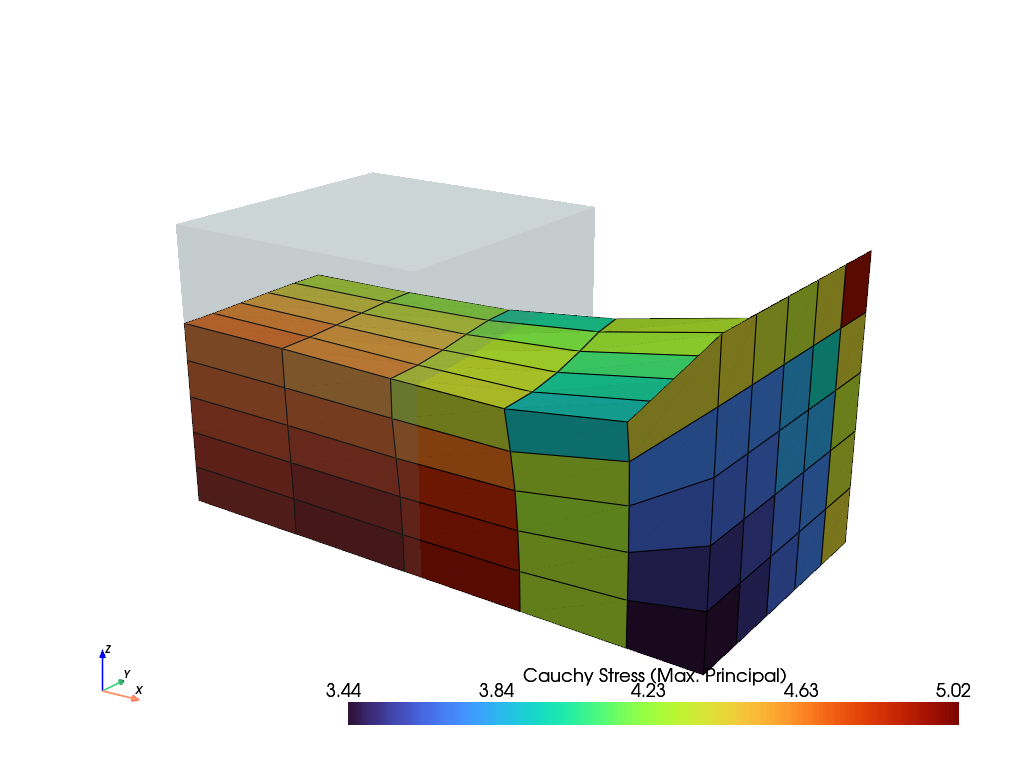
References
See also
felupe.StateNearlyIncompressibleA State with internal cell-wise constant fields for (nearly) incompressible solid bodies.
- class felupe.StateNearlyIncompressible(field)[source]#
Bases:
objectA State with internal cell-wise constant dual fields for (nearly) incompressible solid bodies.
Notes
The internal fields \(p\) and \(\bar{J}\) are treated as state variables, directly derived from the displacement field. Hence, these dual fields are not exported to the global degrees of freedom.
- Parameters:
field (FieldContainer) – A field container with the displacement field.
See also
felupe.SolidBodyNearlyIncompressibleA (nearly) incompressible solid body with methods for the assembly of sparse vectors/matrices.
- integrate_shape_function_gradient(parallel=False, out=None)[source]#
Integrated sub-block matrix containing the shape-functions gradient w.r.t. the deformed coordinates \(\boldsymbol{K}_{\boldsymbol{u}p}\).
\[\int_V \delta \boldsymbol{F} : \frac{\partial J}{\partial \boldsymbol{F}} ~ dV\ \Delta p \longrightarrow \boldsymbol{K}_{\boldsymbol{u}p}\]
- class felupe.SolidBodyGravity(field, gravity=None, density=1.0)[source]#
Bases:
objectA gravity (body) force on a solid body.
- Parameters:
field (FieldContainer) – A field container with fields created on a boundary region.
gravity (ndarray or None, optional) – The prescribed values of gravity \(\boldsymbol{g}\) (default is None). If None, the gravity vector is set to zero (the dimension of the gravity vector is derived from the first field of the field container).
density (float, optional) – The density \(\rho\) of the solid body (default is 1.0).
Notes
\[\delta W_{ext} = \int_V \delta \boldsymbol{u} \cdot \rho \boldsymbol{g} \ dV\]Examples
>>> import felupe as fem >>> >>> mesh = fem.Cube(n=6) >>> region = fem.RegionHexahedron(mesh) >>> field = fem.FieldContainer([fem.Field(region, dim=3)]) >>> boundaries = fem.dof.symmetry(field[0]) >>> >>> umat = fem.NeoHooke(mu=1, bulk=2) >>> solid = fem.SolidBody(umat, field) >>> gravity = fem.SolidBodyGravity(field, density=1.0) >>> >>> table = fem.math.linsteps([0, 1], num=5, axis=0, axes=3) >>> step = fem.Step( ... items=[solid, gravity], ... ramp={gravity: 2 * table}, ... boundaries=boundaries, ... ) >>> >>> job = fem.Job(steps=[step]).evaluate() >>> solid.plot("Principal Values of Cauchy Stress").show()
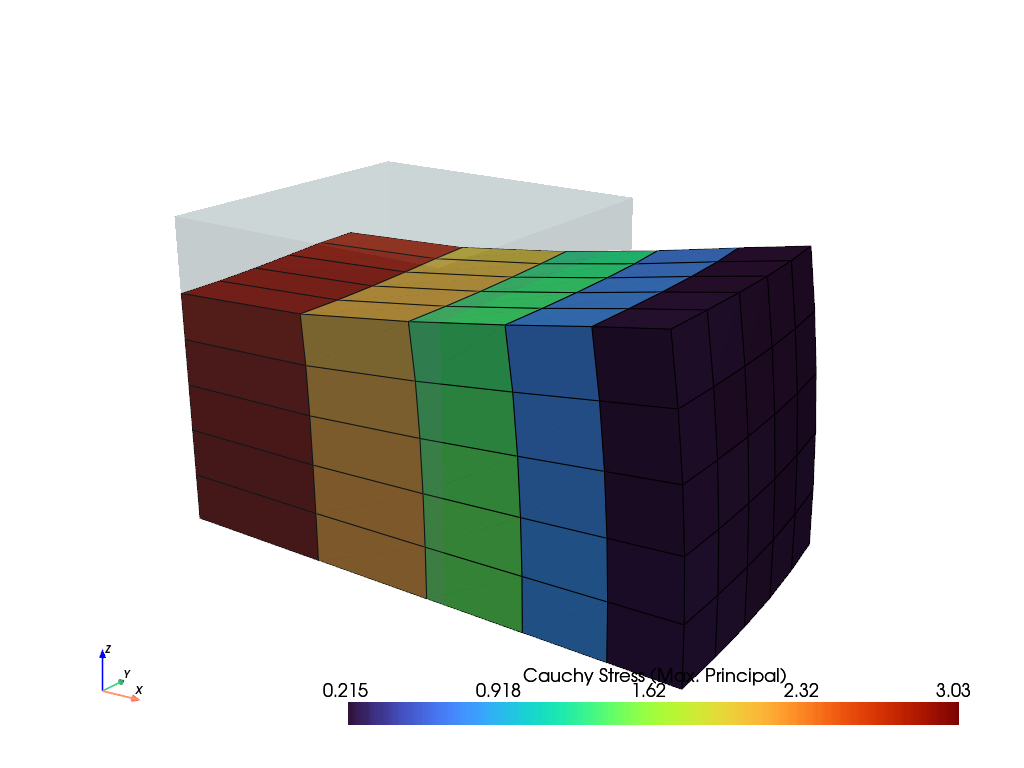
- class felupe.SolidBodyPressure(field, pressure=None)[source]#
Bases:
objectA hydrostatic pressure boundary on a solid body.
- Parameters:
field (FieldContainer) – A field container with fields created on a boundary region.
pressure (float or ndarray or None, optional) – A scaling factor for the prescribed pressure \(p\) (default is None). If None, the pressure is set to zero.
Notes
\[\delta W_{ext} = \int_{\partial V} \delta \boldsymbol{u} \cdot p J \boldsymbol{F}^{-T} \ d\boldsymbol{A}\]Examples
>>> import felupe as fem >>> >>> mesh = fem.Rectangle(n=6) >>> region = fem.RegionQuad(mesh) >>> field = fem.FieldContainer([fem.FieldAxisymmetric(region, dim=2)]) >>> boundaries = fem.dof.symmetry(field[0]) >>> umat = fem.NeoHooke(mu=1, bulk=2) >>> solid = fem.SolidBody(umat, field) >>> >>> region_pressure = fem.RegionQuadBoundary( ... mesh=mesh, ... only_surface=True, # select only faces on the outline ... mask=mesh.points[:, 0] == 1, # select a subset of faces on the surface ... ensure_3d=True, # requires True for axisymmetric/plane strain, otherwise False ... ) >>> field_boundary = fem.FieldContainer([fem.FieldAxisymmetric(region_pressure, dim=2)]) >>> pressure = fem.SolidBodyPressure(field=field_boundary) >>> >>> table = fem.math.linsteps([0, 1], num=5) >>> step = fem.Step( ... items=[solid, pressure], ramp={pressure: 1 * table}, boundaries=boundaries ... ) >>> >>> job = fem.Job(steps=[step]).evaluate() >>> solid.plot( ... "Principal Values of Cauchy Stress", component=2, clim=[-1.01, -0.99] ... ).show()
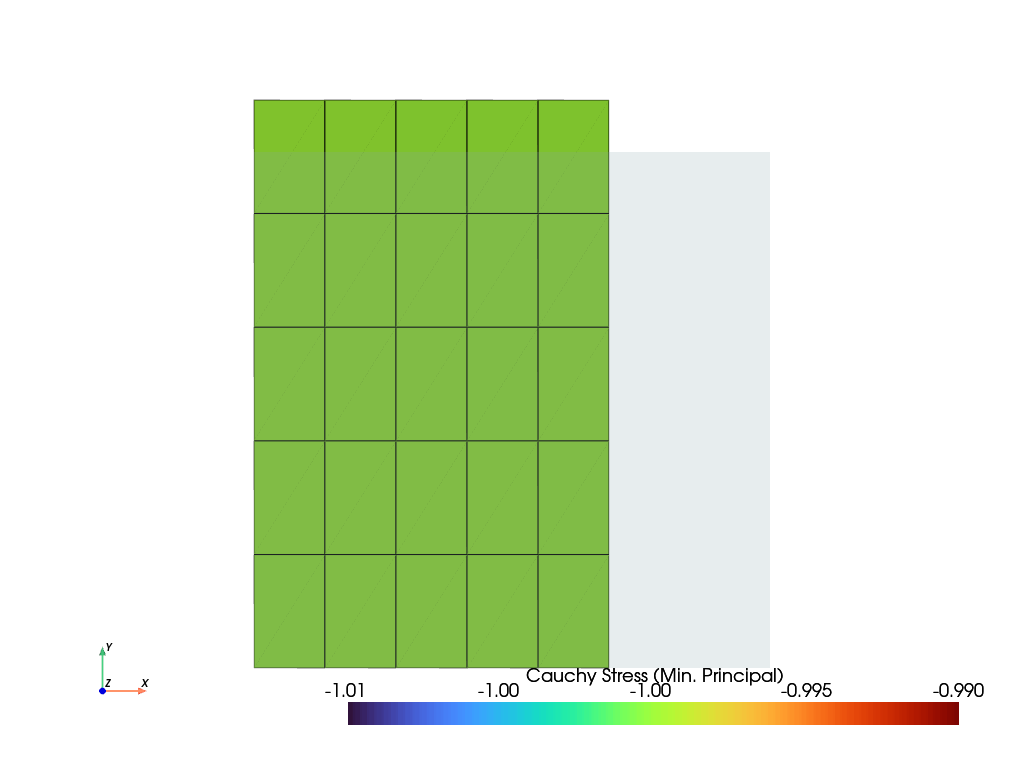
- class felupe.PointLoad(field, points, values=None, apply_on=0, axisymmetric=False)[source]#
Bases:
objectA point load with methods for the assembly of sparse vectors/matrices.
- class felupe.Step(items, ramp=None, boundaries=None)[source]#
Bases:
objectA Step with multiple substeps, subsequently depending on the solution of the previous substep.
- Parameters:
items (list of SolidBody, SolidBodyNearlyIncompressible, SolidBodyPressure, SolidBodyGravity, PointLoad, MultiPointConstraint or MultiPointContact) – A list of items with methods for the assembly of sparse vectors/matrices.
ramp (dict, optional) – A dict with
Boundaryoritem-keys which holds the array of values to ramp (default is None). If None, only one substep is evaluated.boundaries (dict of Boundary, optional) – A dict with
Boundaryconditions (default is None).
Examples
>>> import felupe as fem >>> >>> mesh = fem.Cube(n=6) >>> region = fem.RegionHexahedron(mesh) >>> field = fem.FieldContainer([fem.Field(region, dim=3)]) >>> >>> boundaries = fem.dof.symmetry(field[0]) >>> boundaries["clamped"] = fem.Boundary(field[0], fx=1, skip=(True, False, False)) >>> boundaries["move"] = fem.Boundary(field[0], fx=1, skip=(False, True, True)) >>> >>> umat = fem.NeoHooke(mu=1, bulk=2) >>> solid = fem.SolidBody(umat, field) >>> >>> move = fem.math.linsteps([0, 1], num=5) >>> step = fem.Step(items=[solid], ramp={boundaries["move"]: move}, boundaries=boundaries) >>> >>> job = fem.Job(steps=[step]).evaluate() >>> ax = solid.plot("Principal Values of Cauchy Stress").show()
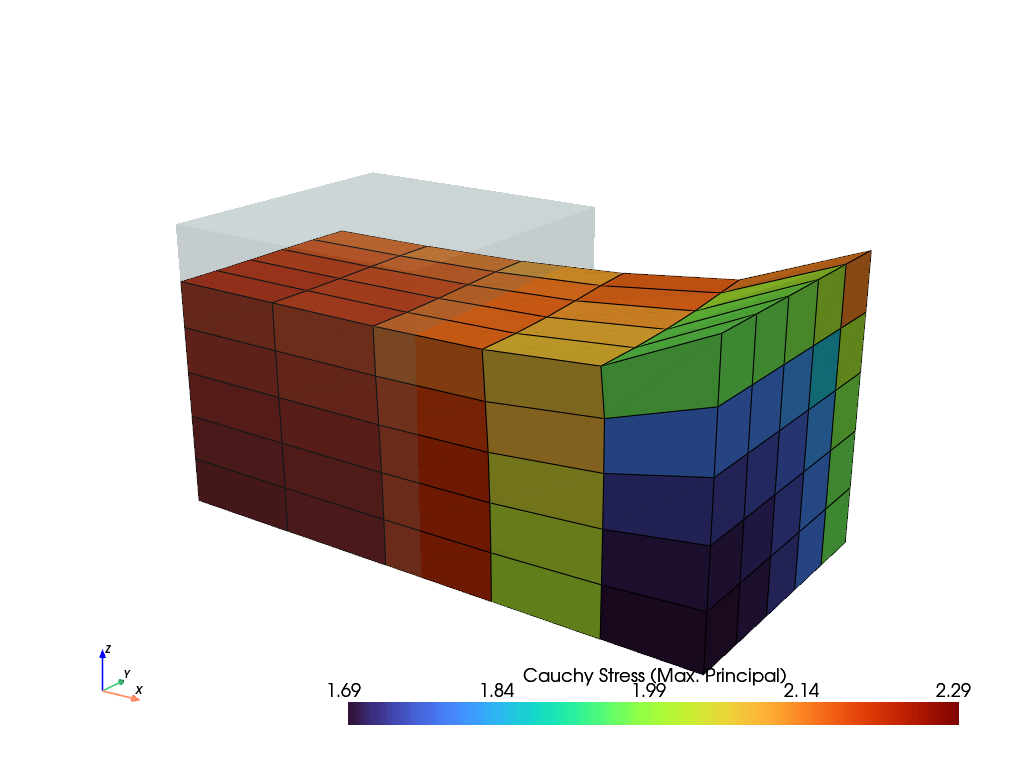
- class felupe.Job(steps, callback=<function Job.<lambda>>, **kwargs)[source]#
Bases:
objectA job with a list of steps and a method to evaluate them.
- Parameters:
steps (list of Step) – A list with steps, where each step subsequently depends on the solution of the previous step.
callback (callable, optional) – A callable which is called after each completed substep. Function signature must be
lambda stepnumber, substepnumber, substep, **kwargs: None, wheresubstepis an instance ofNewtonResult. The field container of the completed substep is available assubstep.x. Default iscallback=lambda stepnumber, substepnumber, substep, **kwargs: None.**kwargs (dict, optional) – Optional keyword-arguments for the
callbackfunction.
- steps#
A list with steps, where each step subsequently depends on the solution of the previous step.
- callback#
A callable which is called after each completed substep. Function signature must be
lambda stepnumber, substepnumber, substep: None, wheresubstepis an instance ofNewtonResult. THe field container of the completed substep is available assubstep.x.- Type:
callable
- timetrack#
A list with times at which the results are written to the XDMF result file.
- fnorms#
List with norms of the objective function for each completed substep of each step. See also class:~felupe.tools.NewtonResult.
Examples
>>> import felupe as fem >>> >>> mesh = fem.Cube(n=6) >>> region = fem.RegionHexahedron(mesh) >>> field = fem.FieldContainer([fem.Field(region, dim=3)]) >>> >>> boundaries = fem.dof.symmetry(field[0]) >>> boundaries["clamped"] = fem.Boundary(field[0], fx=1, skip=(True, False, False)) >>> boundaries["move"] = fem.Boundary(field[0], fx=1, skip=(False, True, True)) >>> >>> umat = fem.NeoHooke(mu=1, bulk=2) >>> solid = fem.SolidBody(umat, field) >>> >>> move = fem.math.linsteps([0, 1], num=5) >>> step = fem.Step(items=[solid], ramp={boundaries["move"]: move}, boundaries=boundaries) >>> >>> job = fem.Job(steps=[step]).evaluate() >>> solid.plot("Principal Values of Cauchy Stress").show()

See also
StepA Step with multiple substeps, subsequently depending on the solution of the previous substep.
CharacteristicCurveA job with a list of steps and a method to evaluate them. Force-displacement curve data is tracked during evaluation for a given
Boundary.tools.NewtonResultA data class which represents the result found by Newton’s method.
- evaluate(filename=None, mesh=None, point_data=None, cell_data=None, point_data_default=True, cell_data_default=True, verbose=None, parallel=False, **kwargs)[source]#
Evaluate the steps.
- Parameters:
filename (str or None, optional) – The filename of the XDMF result file. Must include the file extension
my_result.xdmf. If None, no result file is writte during evaluation. Default is None.mesh (Mesh or None, optional) – A mesh which is used for the XDMF time series writer. If None, it is taken from the field of the first item of the first step if no keyword argument
x0is given. If None andx0=field, the mesh is taken from thex0field container. Default is None.point_data (dict or None, optional) – Additional dict of point-data for the meshio XDMF time series writer.
cell_data (dict or None, optional) – Additional dict of cell-data for the meshio XDMF time series writer.
point_data_default (bool, optional) – Flag to write default point-data to the XDMF result file. This includes
"Displacement". Default is True.cell_data_default (bool, optional) – Flag to write default cell-data to the XDMF result file. This includes
"Principal Values of Logarithmic Strain","Logarithmic Strain"and"Deformation Gradient". Default is True.verbose (bool or int or None, optional) – Verbosity level to control how messages are printed during evaluation. If 1 or True and
tqdmis installed, a progress bar is shown. Iftqdmis missing or verbose is 2, more detailed text-based messages are printed. Default is None. If None, verbosity is set to True. If None and the environmental variable FELUPE_VERBOSE is set and its value is nottrue, then logging is turned off.parallel (bool, optional) – Flag to use a threaded version of
numpy.einsum()during assembly. Requireseinsumt. This may add additional overhead to small-sized problems. Default is False.**kwargs (dict) – Optional keyword arguments for
generate(). Ifparallel=True, it is added askwargs["parallel"] = Trueto the dict of additional keyword arguments. Ifx0is present inkwargs.keys(), it is used as the mesh for the XDMF time series writer.
- Returns:
The job object.
- Return type:
Notes
Requires
meshioandh5pyiffilenameis not None. Also requirestqdmfor an interactive progress bar ifverbose=True.See also
StepA Step with multiple substeps, subsequently depending on the solution of the previous substep.
CharacteristicCurveA job with a list of steps and a method to evaluate them. Force-displacement curve data is tracked during evaluation for a given
Boundarycondition.tools.NewtonResultA data class which represents the result found by Newton’s method.
- class felupe.CharacteristicCurve(steps, boundary, items=None, callback=<function CharacteristicCurve.<lambda>>, **kwargs)[source]#
Bases:
JobA job with a list of steps and a method to evaluate them. Force-displacement curve data is tracked during evaluation for a given
Boundaryby a built-incallback.- Parameters:
steps (list of Step) – A list with steps, where each step subsequently depends on the solution of the previous step.
items (list of SolidBody, SolidBodyNearlyIncompressible, SolidBodyPressure, SolidBodyGravity, PointLoad, MultiPointConstraint, MultiPointContact or None, optional) – A list of items with methods for the assembly of sparse vectors/matrices which are used to evaluate the sum of reaction forces. If None, the total reaction forces from the
NewtonResultof the substep are used.callback (callable, optional) – A callable which is called after each completed substep. Function signature must be
lambda stepnumber, substepnumber, substep, **kwargs: None, wheresubstepis an instance ofNewtonResult. The field container of the completed substep is available assubstep.x. Default iscallback=lambda stepnumber, substepnumber, substep, **kwargs: None.**kwargs (dict, optional) – Optional keyword-arguments for the
callbackfunction.
Examples
>>> import felupe as fem >>> >>> mesh = fem.Cube(n=6) >>> region = fem.RegionHexahedron(mesh) >>> field = fem.FieldContainer([fem.Field(region, dim=3)]) >>> >>> boundaries = dict() >>> boundaries["fixed"] = fem.Boundary(field[0], fx=0, skip=(False, False, False)) >>> boundaries["clamped"] = fem.Boundary(field[0], fx=1, skip=(True, False, False)) >>> boundaries["move"] = fem.Boundary(field[0], fx=1, skip=(False, True, True)) >>> >>> umat = fem.NeoHooke(mu=1, bulk=2) >>> solid = fem.SolidBody(umat, field) >>> >>> move = fem.math.linsteps([0, 1], num=5) >>> step = fem.Step(items=[solid], ramp={boundaries["move"]: move}, boundaries=boundaries) >>> >>> job = fem.CharacteristicCurve(steps=[step], boundary=boundaries["move"]).evaluate() >>> fig, ax = job.plot( ... xlabel=r"Displacement $u_1$ in mm $\rightarrow$", ... ylabel=r"Normal Force in $F_1$ in N $\rightarrow$", ... marker="o", ... )
>>> solid.plot("Principal Values of Cauchy Stress").show()
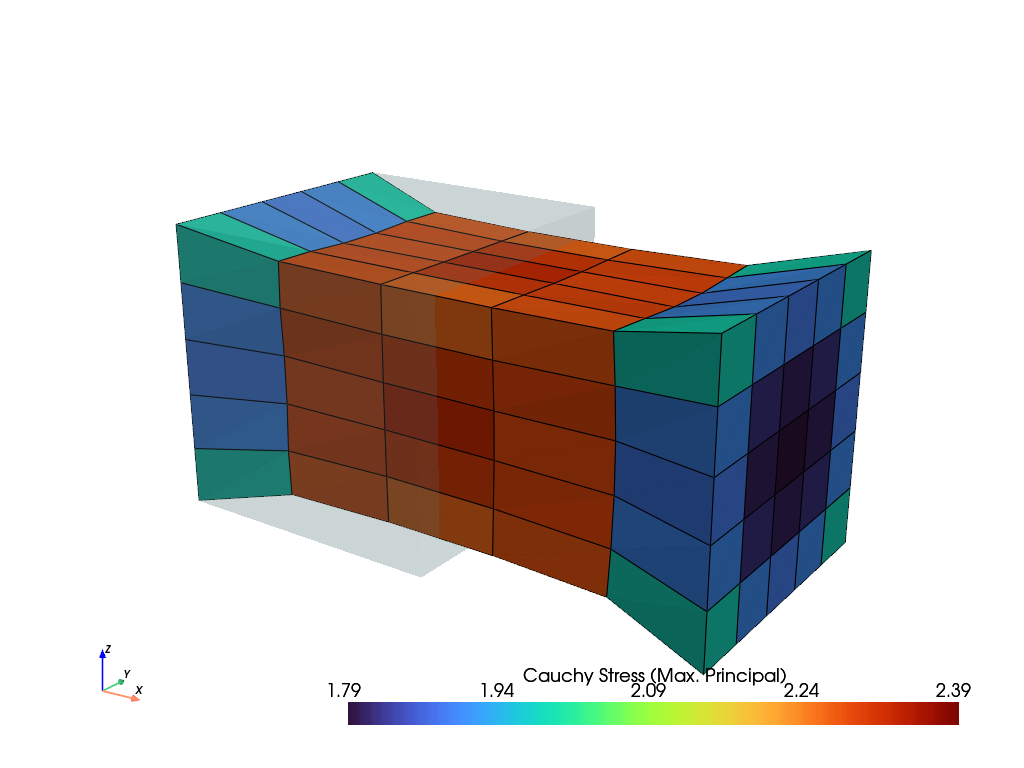
See also
StepA Step with multiple substeps, subsequently depending on the solution of the previous substep.
JobA job with a list of steps and a method to evaluate them.
tools.NewtonResultA data class which represents the result found by Newton’s method.
- plot(x=None, y=None, xaxis=0, yaxis=0, xlabel=None, ylabel=None, xscale=1.0, yscale=1.0, xoffset=0.0, yoffset=0.0, gradient=False, swapaxes=False, ax=None, items=None, **kwargs)[source]#
Plot force-displacement characteristic curves on a pre-evaluated job, tracked on a given
Boundary.- Parameters:
x (list of ndarray or None, optional) – A list with arrays of displacement data. If None, the displacement is taken from the first field of the field container from each completed substep. The displacement data is then taken from the first point of the tracked
Boundary. Default is None.y (list of ndarray or None, optional) – A list with arrays of reaction force data. If None, the force is taken from the
NewtonResultof each completed substep. Default is None.xaxis (int, optional) – The axis for the displacement data (default is 0).
yaxis (int, optional) – The axis for the reaction force data (default is 0).
xlabel (str or None, optional) – The label of the x-axis (default is None).
ylabel (str or None, optional) – The label of the y-axis (default is None).
xscale (float, optional) – A scaling factor for the displacement data (default is 1.0).
yscale (float, optional) – A scaling factor the reaction force data (default is 1.0).
xoffset (float, optional) – An offset for the displacement data (default is 0.0).
yoffset (float, optional) – An offset for the reaction force data (default is 0.0).
gradient (bool, optional) – A flag to plot the gradient of the y-data. Uses
numpy.gradient(edge_order=2). The gradient data is set tonp.nanfor absolute values greater than the mean value plus two times the standard deviation. Default is False.swapaxes (bool, optional) – A flag to flip the plot (x, y) to (y, x). Also changes the labels.
ax (matplotlib.axes.Axes) – An axes object where the plot is placed in.
items (slice, ndarray or None) – Indices or a range of data points to plot. If None, all data points are plotted (default is None).
**kwargs (dict) – Additional keyword arguments for plotting in
ax.plot(**kwags).
- Returns:
fig (matplotlib.figure.Figure) – The figure object where the plot is placed in.
ax (matplotlib.axes.Axes) – The axes object where the plot is placed in.